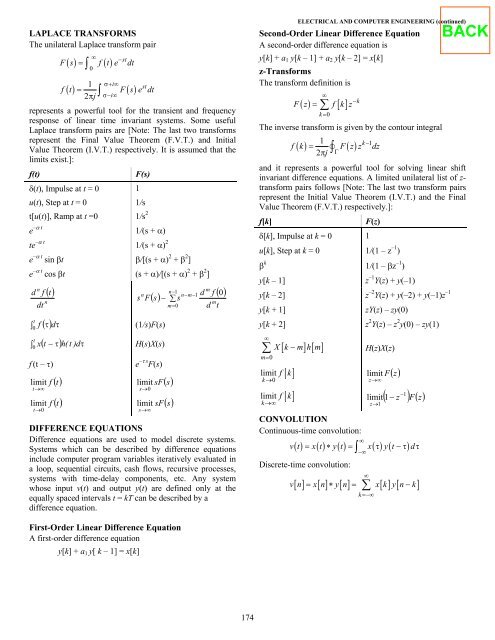fundamentals of engineering supplied-reference handbook - Ventech!
fundamentals of engineering supplied-reference handbook - Ventech!
fundamentals of engineering supplied-reference handbook - Ventech!
Create successful ePaper yourself
Turn your PDF publications into a flip-book with our unique Google optimized e-Paper software.
LAPLACE TRANSFORMS<br />
The unilateral Laplace transform pair<br />
∞ −st<br />
0<br />
( ) = ∫ ( )<br />
F s f t e dt<br />
1 σ+ i∞ st<br />
f () t = F( s) e dt<br />
2πj<br />
∫ σ−i∞ represents a powerful tool for the transient and frequency<br />
response <strong>of</strong> linear time invariant systems. Some useful<br />
Laplace transform pairs are [Note: The last two transforms<br />
represent the Final Value Theorem (F.V.T.) and Initial<br />
Value Theorem (I.V.T.) respectively. It is assumed that the<br />
limits exist.]:<br />
f(t) F(s)<br />
δ(t), Impulse at t = 0 1<br />
u(t), Step at t = 0 1/s<br />
t[u(t)], Ramp at t =0 1/s 2<br />
–α t<br />
e<br />
1/(s + α)<br />
te –α t 1/(s + α) 2<br />
e –α t sin βt β/[(s + α) 2 + β 2 ]<br />
e –α t cos βt (s + α)/[(s + α) 2 + β 2 ]<br />
n<br />
d f<br />
dt<br />
t<br />
() t<br />
n<br />
() τ<br />
s<br />
n<br />
F<br />
() s<br />
∫0<br />
f dτ<br />
(1/s)F(s)<br />
∫<br />
( t − τ)<br />
t<br />
0 x h(<br />
t ) dτ<br />
H(s)X(s)<br />
f (t – τ) e –τ s F(s)<br />
limit f () t<br />
limit sF()<br />
s<br />
t→∞ limit<br />
t→0 f () t<br />
s→0 limit<br />
s→∞ n 1<br />
n m 1<br />
− ∑ s<br />
m 0<br />
−<br />
− −<br />
=<br />
sF()<br />
s<br />
m<br />
d f<br />
m<br />
d t<br />
( 0)<br />
DIFFERENCE EQUATIONS<br />
Difference equations are used to model discrete systems.<br />
Systems which can be described by difference equations<br />
include computer program variables iteratively evaluated in<br />
a loop, sequential circuits, cash flows, recursive processes,<br />
systems with time-delay components, etc. Any system<br />
whose input v(t) and output y(t) are defined only at the<br />
equally spaced intervals t = kT can be described by a<br />
difference equation.<br />
First-Order Linear Difference Equation<br />
A first-order difference equation<br />
y[k] + a1 y[ k – 1] = x[k]<br />
174<br />
ELECTRICAL AND COMPUTER ENGINEERING (continued)<br />
Second-Order Linear Difference Equation<br />
A second-order difference equation is<br />
y[k] + a1 y[k – 1] + a2 y[k – 2] = x[k]<br />
z-Transforms<br />
The transform definition is<br />
∞<br />
F( z) = ∑ f [ k] z<br />
k=<br />
0<br />
−k<br />
The inverse transform is given by the contour integral<br />
1<br />
k −1<br />
f ( k) = F( z) z dz<br />
2πj<br />
∫� Γ<br />
and it represents a powerful tool for solving linear shift<br />
invariant difference equations. A limited unilateral list <strong>of</strong> ztransform<br />
pairs follows [Note: The last two transform pairs<br />
represent the Initial Value Theorem (I.V.T.) and the Final<br />
Value Theorem (F.V.T.) respectively.]:<br />
f[k] F(z)<br />
δ[k], Impulse at k = 0 1<br />
u[k], Step at k = 0 1/(1 – z –1 )<br />
β k<br />
1/(1 – βz –1 )<br />
y[k – 1]<br />
z –1 Y(z) + y(–1)<br />
y[k – 2] z –2 Y(z) + y(–2) + y(–1)z –1<br />
y[k + 1] zY(z) – zy(0)<br />
y[k + 2] z 2 Y(z) – z 2 y(0) – zy(1)<br />
∞<br />
∑ X [ k − m] h[ m]<br />
H(z)X(z)<br />
m=<br />
0<br />
k→0<br />
[ ]<br />
limit f k<br />
[ ]<br />
limit f k<br />
k→∞<br />
CONVOLUTION<br />
Continuous-time convolution:<br />
limit F<br />
z→∞ limit<br />
z→1<br />
( z)<br />
−1<br />
( 1−<br />
z ) F(<br />
z)<br />
() () () ∫ ( ) ( )<br />
vt = xt∗ yt = xτ yt−τ dτ<br />
Discrete-time convolution:<br />
∞<br />
−∞<br />
[ ] = [ ] ∗ [ ] = ∑<br />
[ ] [ − ]<br />
vn xn yn xk yn k<br />
∞<br />
k =−∞
















